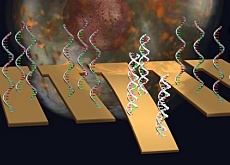
Scientists make gene detection breakthrough

Researchers from the Swiss Nanoscience Institute in Basel have developed a new method to detect genes relevant to diseases and their treatment.
It is hoped that this technique will eventually lead to personalised medical diagnostics for patients and will give a better idea of how molecular processes in the body work.
The new method detects active genes directly by using sensors attached to tiny silicon cantilevers that are only 450 nanometres thick. A nanometre is one millionth of a millimetre.
The cantilevers bend when they detect specific gene activity in a sample, a result that can be measured optically. One device with a series of sensors could also be used to measure the activity of different genes.
The nanomechanical detector is extremely sensitive and precise according to the Basel scientists.
“Current genetic analysis technology relies on methods that distort the molecules,” said Christoph Gerber, who led the research team.
The advantage of the new technique is that there is no distortion. It also allows users to literally go fishing for individual genes, which is especially interesting since they are often an indicator of what ails a person.
“If you get sick say with cancer, it is the result of a genetic malfunction,” Gerber told swissinfo. “The gene is either switched on or off, or is even idle, and if something goes wrong, this can lead to disease.”
Personal
Gerber believes that once a malfunction has been identified, you can measure the impact of drugs used to treat a disease. “It’s the starting point for personalised medical diagnostics,” he added.
Roche, the Swiss pharmaceutical company with major interests in the diagnostics business, has been following the research closely.
The firm believes that because the method works within minutes, it could be used as a real-time monitor for a patient’s response to a given treatment, allowing doctors to sidestep unwanted side effects.
Gene activity varies from individual to individual depending on heredity, so what works for one patient might not for another.
Gerber admits that the technique could in theory be applied to any disease with a molecular basis. But he feels it could lead to a far more ambitious result: to help understand what makes us tick now that the human genome has been mapped out.
Decoding humans
“The decoding of the human genome showed that a smaller number of genes than previously thought are responsible for our body’s molecular processes,” he told swissinfo.
“Those genes have multiple functions. We know now what we are made of, but we don’t understand how we function yet.”
The nanoscience institute is hoping to shrink the detectors even further, making them more sensitive and cheaper in the long run. Work has already begun with Roche with the aim of implementing personalised diagnostics.
Gerber warns though it will take at least another five years before this technique is used on a regular basis with patients.
The results of the research are published in this month’s issue of the science journal Nature Nanotechnology.
swissinfo, Scott Capper
A genome is made up of all the DNA in an organism, including its genes.
Genes carry information for making all the proteins required by all organisms.
These proteins determine, among other things, how the organism looks, how well its body metabolizes food or fights infection, and sometimes even how it behaves.
Nanoscience and nanotechnology encompass a range of techniques rather than a single discipline, and stretch across the whole spectrum of science, touching on medicine, physics, engineering and chemistry.
The size and scale of the nanotechnology industry is unclear in Switzerland. One reason is that there is no international standard definition of the science, making it hard to determine whether companies use nanotechnology or not.
According to the US-based Project on Emerging Nanotechnologies, this technology was incorporated into more than $30 billion (SFr37.3 billion) in manufactured goods in 2005, more than double the previous year’s figure.

In compliance with the JTI standards
More: SWI swissinfo.ch certified by the Journalism Trust Initiative
















![The four-metre-long painting "Sonntag der Bergbauern" [Sunday of the Mountain Farmers, 1923-24/26] had to be removed by a crane from the German Chancellery in Berlin for the exhibition in Bern.](https://www.swissinfo.ch/content/wp-content/uploads/sites/13/2025/12/01_Pressebild_KirchnerxKirchner.jpg?ver=a45b19f3)











You can find an overview of ongoing debates with our journalists here . Please join us!
If you want to start a conversation about a topic raised in this article or want to report factual errors, email us at english@swissinfo.ch.